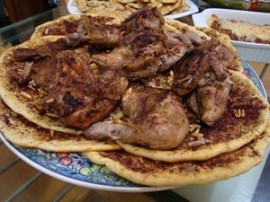Unfortunately, I have fallen way behind in the A to Z blogging challenge! This being my first time, I don’t know what the official rules are … but I am taking more of a NaNoWriMo approach to it. As long as I push through and get all 26 entries done by the end of the month then I will be satisfied. This also means that I am going to have to make my posts a lot shorter. So here goes.
Olives
One of the delights of Jordan is that delicious olives are readily available. Most markets (both the open air variety and the western-style super market) have a large selection of fresh olives, not unlike a deli counter back home. Although prices vary, and I never really bought olives by the kilo back home, my impression is that it is much cheaper to keep yourself in olives here than back in the states. Jordan is 12th in the world for olive production … which may not sound overly impressive until you realize it is 96th in the world for GDP, 106th for population, 112th for land area and then you realize that tiny Jordan is holding its own on Olive production!
It seems that almost everyone here who has a little bit of land has an olive tree or two. When we moved into our new place we actually had a garden with 9 olive trees! Trees can either be pruned for cultivation or allowed to grow a bit wild for shade. These ones were definitely left for shade and we are thinking about having them pruned back for production as you can pick your own olives and have them milled into fresh oil. However, friends of ours who have perhaps a dozen trees picked a lot of olives this year and when they brought their pickings to the miller he laughed and out of sympathy milled them for them. It produced a couple of liters of olive oil only. Apparently it takes 5-7 kilos (11-15 lbs) of olives to make a liter of olive oil! The miller usually was dealing with 100s of kilos of olives.
If your olive trees over hang into the street the poor are allowed to glean from them and this year I witnessed this a few times. Sometimes people will knock on your door and ask if they can harvest your olives if you do not want them. Olive trees are hardy, living for hundreds (some say thousands) of years, providing sustenance and income for a family for generations.
Filed under: Food | Tagged: A to Z Challenge, Food, Jordan, olives | 1 Comment »


















